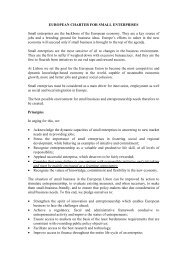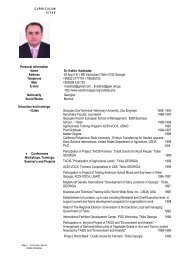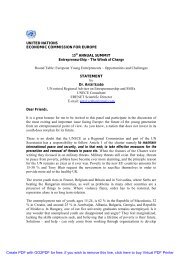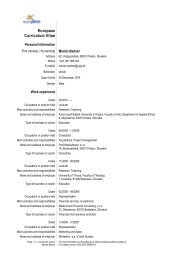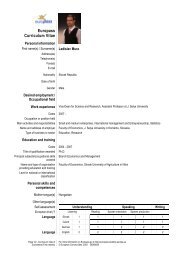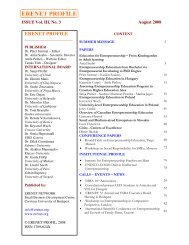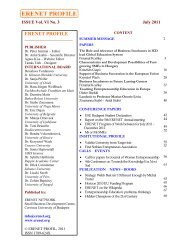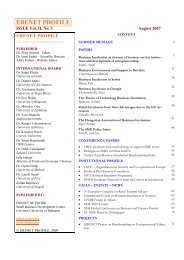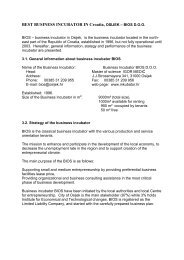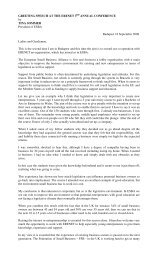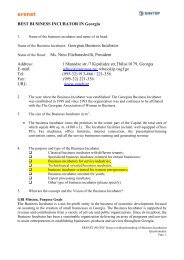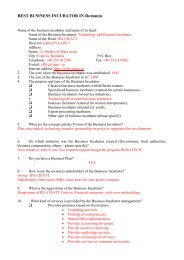Strategies of the Development of Entrepreneurship and SME
Strategies of the Development of Entrepreneurship and SME
Strategies of the Development of Entrepreneurship and SME
Create successful ePaper yourself
Turn your PDF publications into a flip-book with our unique Google optimized e-Paper software.
ROMANIASTRENGHTWEAKNESS• Stabilisation <strong>of</strong> macroeconomic environment<strong>and</strong> <strong>of</strong> <strong>the</strong> regulation framework;• According to <strong>the</strong> Law no. 370/2002 wascreated <strong>the</strong> One-Stop-Shop national networkfor registration <strong>and</strong> authorization <strong>of</strong> <strong>the</strong>enterprises;• The registration procedures for newly establishedenterprises is simplified <strong>and</strong> reduces <strong>the</strong>procedural terms for obtaining <strong>the</strong> registrationcertificate in 3 or maximum 5 days;• The increasing <strong>of</strong> <strong>SME</strong>s economic potential in<strong>the</strong> productive <strong>and</strong> service sectors;• Qualification, adaptability <strong>and</strong> relatively lowprice <strong>of</strong> labour force <strong>and</strong> good educationallevel <strong>of</strong> economically active population;• National Council <strong>of</strong> Small <strong>and</strong> Medium-sizedPrivate Enterprises in Romania – CNIPMMR– represents <strong>the</strong> interest <strong>of</strong> entrepreneursagainst <strong>the</strong> Government;• The <strong>SME</strong>s have a foreground access to publicfounds <strong>and</strong> to <strong>the</strong> national R&D plan.• Less predictable macroeconomic conditionsfor <strong>SME</strong>s growth, compared to those <strong>of</strong> EU;• Lack <strong>of</strong> <strong>the</strong> new technologies <strong>and</strong> updateequipment, low labour productivity <strong>and</strong>pr<strong>of</strong>itability, low competitiveness <strong>and</strong> absence<strong>of</strong> linkages between research institutes <strong>and</strong> <strong>the</strong>productive sector;• Insufficient development <strong>of</strong> high qualitybusiness support services;• Low level <strong>of</strong> entrepreneurial curricula atsecondary schools <strong>and</strong> universities;• Low level <strong>of</strong> <strong>the</strong> management <strong>and</strong> marketingskills in <strong>SME</strong>s;• Large disparities in <strong>the</strong> economic <strong>and</strong> socialdevelopment <strong>of</strong> regions;• High level <strong>of</strong> corruption at state <strong>and</strong>regional/municipal level;• A large number <strong>of</strong> controls over <strong>SME</strong>s by <strong>the</strong>public institutions;• Low level <strong>of</strong> <strong>the</strong> labour productivity.OPPORTUNITYTHREATS• EU integration provides opportunities t<strong>of</strong>inance <strong>SME</strong> related initiatives <strong>and</strong> projects;• Exp<strong>and</strong>ing service sector especially in ITCsector <strong>and</strong> increasing dem<strong>and</strong> on <strong>the</strong> fasterspread <strong>of</strong> results in information technology;• Reform <strong>of</strong> public finance system through <strong>the</strong>fiscal code <strong>and</strong> fiscal code procedures;• Increasing <strong>of</strong> <strong>the</strong> FDI investments in Romania;• Increasing <strong>of</strong> <strong>the</strong> <strong>SME</strong>s export weight on EUmarket <strong>and</strong> concerning <strong>of</strong> <strong>the</strong> <strong>SME</strong>s regarding<strong>the</strong> implementation <strong>of</strong> <strong>the</strong> EU st<strong>and</strong>ards <strong>and</strong>quality management systems• There are fiscal facilities for students who wantto start <strong>the</strong>ir own business, being remitted <strong>the</strong>initial costs <strong>of</strong> getting <strong>the</strong> authorizations;• Continuation <strong>of</strong> <strong>the</strong> economic growth <strong>and</strong> <strong>the</strong>low level <strong>of</strong> inflation rate will contribute to <strong>the</strong>growth <strong>of</strong> <strong>the</strong> <strong>SME</strong>s performance level.• Unavoidable decreasing in competitiveness <strong>of</strong>key branches <strong>of</strong> regional industry as aconsequence <strong>of</strong> growth <strong>of</strong> relative unit labourcosts;• Outflow <strong>of</strong> qualified workforce abroad;• Increasing regional disparities related to <strong>the</strong>value added realized by enterprises;• The new judicial procedure regarding <strong>the</strong> exitfrom <strong>the</strong> market is slowly applied;• Low economic level <strong>of</strong> <strong>the</strong> rural regionscompared with <strong>the</strong> urban areas;• Frequent change <strong>of</strong> <strong>the</strong> legal frameworkcreates an important impediment on long termplanning .Source: (1) Romania’s Country <strong>SME</strong> Statistics, Bucharest, 2004; <strong>and</strong>(2) ERENET analyses, 2007(3) Dr. Daniela Stefanescu, Head <strong>of</strong> Management Department, Faculty <strong>of</strong> Economics <strong>and</strong> AdministrativeSciences, Petru Maior University, Targu Mures (Romania)148



